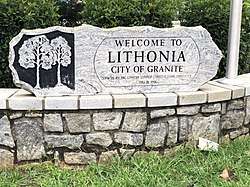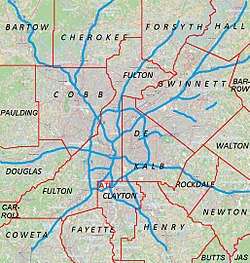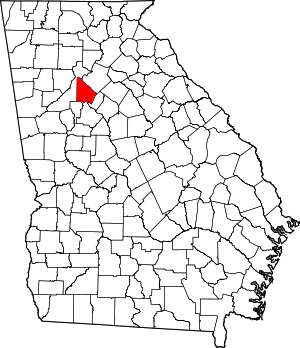Lithonia, Georgia
Lithonia is a city in eastern DeKalb County, Georgia, United States. The city's population was 1,924 at the 2010 census.[5] Lithonia is in the Atlanta metropolitan area.
Lithonia, Georgia | |
|---|---|
 Welcome sign on Main Street in Lithonia | |
| Motto(s): City of Granite | |
 Location in DeKalb County and the state of Georgia | |
 Lithonia, Georgia Location in the Atlanta metropolitan area | |
| Coordinates: 33°42′46″N 84°6′21″W | |
| Country | United States |
| State | Georgia |
| County | DeKalb |
| Government | |
| • Mayor | Shameka Reynolds |
| • DeKalb County CEO | Michael L. Thurmond |
| Area | |
| • Total | 0.93 sq mi (2.41 km2) |
| • Land | 0.93 sq mi (2.40 km2) |
| • Water | 0.00 sq mi (0.00 km2) |
| Elevation | 925 ft (282 m) |
| Population (2010) | |
| • Total | 1,924 |
| • Estimate (2019)[2] | 2,331 |
| • Density | 2,511.85/sq mi (970.03/km2) |
| Time zone | UTC-5 (Eastern (EST)) |
| • Summer (DST) | UTC-4 (EDT) |
| ZIP codes | 30038, 30058 |
| Area code(s) | 770, [678] |
| FIPS code | 13-46860[3] |
| GNIS feature ID | 0325978[4] |
| Website | cityoflithoniaga |
"Lithonia" means "city/town of stone". Lithonia is in the heart of the Georgian granite-quarrying and viewing region, hence the name of the town, from the Greek λίθος lithos, for stone.[6] The huge nearby granite dome, Stone Mountain, is composed of a rock called granite, while the Lithonia gneiss, is a form of metamorphic rock. The Stone Mountain Granite is younger than, and has intruded, the Lithonia Gneiss. The area has a history of rock quarries. The mines were served by the Georgia Railroad and Atlanta, Stone Mountain & Lithonia Railway. Some of the rock quarries have been converted to parkland and the rail lines to rail-trail.
Lithonia is one of the gateways to the Arabia Mountain National Heritage Area,[7] which is largely contained inside Stonecrest, GA.
Geography
Lithonia is located in southeastern DeKalb County at 33°42′46″N 84°6′21″W (33.712658, -84.105897).[8] Interstate 20 passes just south of the community, with access from Exits 74 and 75. Lithonia is 18 miles (29 km) east of the center of Atlanta. Some areas in extreme southern Gwinnett County use a Lithonia postal address near the county line.
According to the United States Census Bureau, the city has a total area of 0.89 square miles (2.3 km2), all land.[5]
History
In 1805, Lithonia began as a small crossroads settlement of farmers. The town grew with the coming of the Atlanta Augusta Railroad in 1845, which allowed the granite quarrying industry in the area to flourish.[9]
Lithonia is the birthplace of the Lithonia Lighting company, one of North America's largest manufacturers of commercial, institutional, industrial and residential light fixtures, which was founded in the city in 1946 but moved to nearby Conyers in the 1950s.
New Birth Missionary Baptist Church, a megachurch which is known for many high-profile funerals, is located in Stonecrest, GA, near Lithonia.
Lithonia Historic District
Lithonia Historic District | |
| Area | 441 acres (178 ha) |
|---|---|
| NRHP reference No. | 16000639[10] |
| Added to NRHP | September 19, 2016 |
The Lithonia Historic District consists of a commercial core surrounded by residential areas, with a period of significance spanning from 1845 to 1964. Stylistic influences in the district include Second Empire, Queen Anne, Folk Victorian, Neoclassical Revival, English Vernacular Revival, Craftsman, and Colonial Revival. The district is bisected by the Georgia/CSX Railroad, which runs perpendicular to the historic commercial core's primary thoroughfare, Main Street. The commercial area extends south from the intersection of Main Street and the railroad, covering a two-block area. The commercial buildings are primarily brick and local granite masonry, with little decorative detailing. Commercial styles include single retail, multiple retail, and retail and office types. Within the historic district, there is some non-historic infill construction such as the 1968 Lithonia Plaza shopping center.
The residential areas consist architecture typical of late 19th- to mid 20th-century types and styles. Residential neighborhoods also feature locally quarried granite and gneiss. House types and styles include the central hall Georgian cottage, gabled-wing cottage, Queen Anne cottage, New South cottage, pyramid cottage, bungalow, Ranch house, I-House and Queen Anne house.

Landmark properties include the Masonic Lodge (1916), The Lithonia Women's Club (1928), the Lithonia First United Methodist Church (1910), Antioch Baptist Church (1911), Lithonia Presbyterian Church, The Union Missionary Church (1911), the Bruce Street equalization school (c.1953), and The Seminary (1895). Contributing sites in the district include two cemeteries, two parks, the former Georgia Railroad Quarry, and the ruins of the Bruce Street School for African-Americans (1938).[9]
The district is significant under National Register criterion A (association with historic events) and C (architecture), with areas of significance in Architecture, Black and European Ethnic Heritage, Community Planning and Development, Industry, and Transportation.
Demographics
| Historical population | |||
|---|---|---|---|
| Census | Pop. | %± | |
| 1880 | 266 | — | |
| 1890 | 1,182 | 344.4% | |
| 1900 | 1,208 | 2.2% | |
| 1910 | 1,428 | 18.2% | |
| 1920 | 1,269 | −11.1% | |
| 1930 | 1,457 | 14.8% | |
| 1940 | 1,554 | 6.7% | |
| 1950 | 1,538 | −1.0% | |
| 1960 | 1,667 | 8.4% | |
| 1970 | 2,270 | 36.2% | |
| 1980 | 2,637 | 16.2% | |
| 1990 | 2,448 | −7.2% | |
| 2000 | 2,187 | −10.7% | |
| 2010 | 1,924 | −12.0% | |
| Est. 2019 | 2,331 | [2] | 21.2% |
| U.S. Decennial Census[11] | |||
Lithonia's city population was 1,924 at the 2010 census, over 799 households, and 560 families residing in the city. The population density was about 1,924 inhabitants per square mile (1,068.9/km2). There were 892 housing units at an average density of 1,129.9 per square mile (436.0/km2). The racial makeup of the city was 84.3% Black, 8.5% White, 0.05% Native American, 0.2% Asian, and 1.42% from other races. Hispanic or Latino of any race were 5.8% of the population.
There were 799 households, out of which 40.8% had children under the age of 18 living with them, 33.3% were married couples living together, 22.6% had a female householder with no husband present, and 29.9% were non-families. 15.7% of all households were made up of individuals, and 4.8% had someone living alone who was 65 years of age or older. The average household size was 2.70 and the average family size was 3.25.
In the city, the population was spread out, with 34.4% under the age of 18, 9.0% from 18 to 24, 27.4% from 25 to 44, 17.4% from 45 to 64, and 11.8% who were 65 years of age or older. The median age was 30 years. For every 100 females, there were 76.7 males. For every 100 females age 18 and over there were 63.1 males.
The median income for a household in the city was $53,397, and the median income for a family was $54,792. Males had a median income of $29,500 versus $24,788 for females. The per capita income for the city was $10,605. About 12.6% of families and 18.9% of the population were below the poverty line, including 31.8% of those under the age of 18 and 25.7% of those 65 and older.
The unincorporated communities located outside the city limits make up almost 75% of the population estimated at over 15,000 inhabitants. Neighborhoods are broken into two ZIP codes: 30058 which includes the City proper, and communities directly outside the city limit, and 30038 located south of Interstate 20 which includes some of the most affluent neighborhoods in DeKalb County.
Shopping
Lithonia is near to a super-regional shopping center, the Mall at Stonecrest (also known as Stonecrest Mall), and serves as the northernmost point on the Arabia Mountain Path.[12] Much of the mall's available property has yet to be developed.
Hospitals
The three main health facilities in Lithonia are:
- Hillandale DeKalb Medical Center is the newest addition to the DeKalb Medical family of hospitals.
- Kaiser Permanente runs two community health clinics in Lithonia: Panola Road Clinic, and the Stonecrest Clinic.
- East DeKalb Health Center
Education
DeKalb County Public Schools operates public schools.[13] Lithonia Middle School is the only school located in the city limits of Lithonia.
The schools that serve the city limits of Lithonia are: Stoneview Elementary School,[14] Lithonia Middle School,[15] and Lithonia High School in Redan CDP.[16]
Elementary schools in the wider surrounding area:
- Edward L. Bouie Sr. Elementary
- Marbut Elementary
- Shadow Rock Elementary
- Rock Chapel Elementary
- Princeton Elementary
- Redan Elementary
- Flat Rock Elementary
- Fairington Elementary
- Stoneview Elementary
- Panola Way Elementary
- Murphy Candler Elementary
- Browns Mill Elementary
- Wynbrooke Traditional Theme School
Middle schools in the surrounding area:
- Lithonia Middle School
- Redan Middle School
- Salem Middle School
- Miller Grove Middle School
- DeKalb Academy of Technology and Environment
High schools in the surrounding area:
- Lithonia High School (Primary Zoned High School)
- Martin Luther King, Jr. High School (Secondary Zoned High School)
- Miller Grove High School (Relief High School)
- Arabia Mountain High School (Magnet High School)
Universities
- Luther Rice University of Theological Studies
- Strayer University
Public libraries
DeKalb County Public Library operates the Lithonia-Davidson Library the main library source in Lithonia, which was once privately owned until being incorporated into the DeKalb County Public Library system in 1947.
Other libraries in the Lithonia area include:
- Salem- Panola Branch
- Redan- Trotti Branch
- Stonecrest- Klondike Branch
Parks
- Browns Mill/Recreation Center
- Bruce Street Park
- Davidson-Arabia Mountain/Preserve
- Fairington Park
- Lithonia Park
- Mystery Valley Golf Course
- Redan Park (included Disc Golf, Tennis course, baseball and football fields, pavilion and family kids play areas)
- Southeast Athletic Complex
- Rock Chapel Park
- Salem Park
Postal service
Lithonia's main post office is located on Stone Mountain Street in the heart of Lithonia. Many drop boxes and postal services storefronts are located throughout the communities of Lithonia.
Redan post office located directly outside the city limits of Lithonia provides an alternative to postal drop off and pickup service.
United Parcel Service (UPS) and FedEx also provide alternative postal service to Lithonia.
Transportation
MARTA (Metropolitan Atlanta Rapid Transit Authority) provides connecting bus service to and from Lithonia, and GRTA Xpress (Georgia Rapid Transit Authority) provides commuter bus service to downtown Atlanta from a community park and ride lot.
References
- "2019 U.S. Gazetteer Files". United States Census Bureau. Retrieved July 9, 2020.
- "Population and Housing Unit Estimates". United States Census Bureau. May 24, 2020. Retrieved May 27, 2020.
- "U.S. Census website". United States Census Bureau. Retrieved January 31, 2008.
- "US Board on Geographic Names". United States Geological Survey. October 25, 2007. Retrieved January 31, 2008.
- "Geographic Identifiers: 2010 Demographic Profile Data (G001): Lithonia city, Georgia". U.S. Census Bureau, American Factfinder. Retrieved October 21, 2015.
- Krakow, Kenneth K. (1975). Georgia Place-Names: Their History and Origins (PDF). Macon, GA: Winship Press. p. 132. ISBN 0-915430-00-2.
- arabiaalliance.org
- "US Gazetteer files: 2010, 2000, and 1990". United States Census Bureau. February 12, 2011. Retrieved April 23, 2011.
- "SUMMARY OF PROPOSED NATIONAL REGISTER/GEORGIA REGISTER NOMINATION" (PDF). Georgia Department of Natural Resources Historic Preservation Division. January 2014. Archived from the original (PDF) on April 16, 2015.
- "National Register Information System". National Register of Historic Places. National Park Service. November 2, 2013.
- "Census of Population and Housing". Census.gov. Retrieved June 4, 2015.
- http://biscuitstudios.com, Biscuit Studios -. "Arabia Mountain PATH - Arabia Mountain National Heritage Area". arabiaalliance.org.
- "Official Zoning Map." City of Lithonia. Adopted July 6, 2015. Retrieved on June 1, 2017.
- "Elementary School Attendance Areas 2016 - 2017 School Year." DeKalb County School System. Retrieved on June 1, 2017.
- "Middle School Attendance Areas 2016 - 2017 School Year." DeKalb County School System. Retrieved on June 1, 2017.
- "High School Attendance Areas 2016 - 2017 School Year." DeKalb County School System. Retrieved on June 1, 2017.
